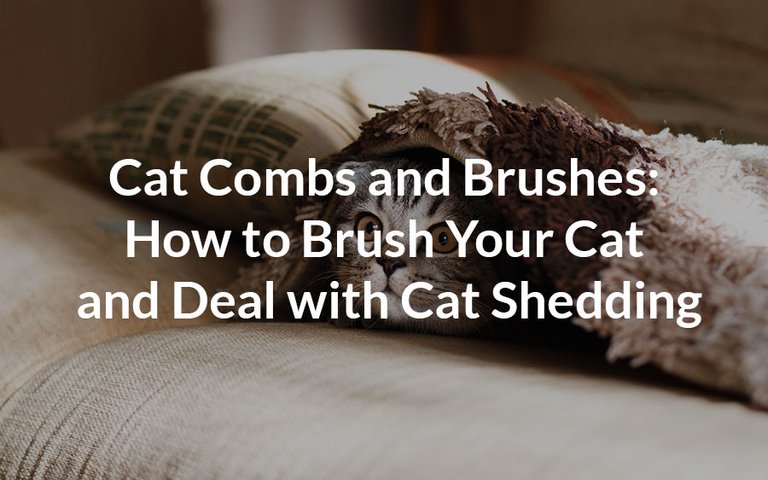
Why Do Cats Need Brushing?
Even though not all felines enjoy being brushed, this part of grooming is essential to keep our cats clean and healthy. While it’s obvious that combing your cat improves her visual appearance (especially if yours is long-haired), there are many more not-so-commonly known advantages to a good brushing. Namely:
● Brushing your long-haired cat will help reduce the hairball problem. Since nothing will prevent your beloved pet from grooming herself every day (self-licking), the most effective way of preventing hairballs is to brush out the loose hair from your cat’s fur from time to time. Many cat owners look for medical solutions to hairballs, or seek specific foods that help prevent hairballs, overlooking this simple, yet supremely effective measure.
● Regular brushing helps to prevent mats from forming on your cat’s fur. Mats can cause your cat extreme amounts of pain and discomfort, since matted fur often covers areas of irritated, itchy skin which, in severe cases, can be a gateway to a serious skin infection. While treating already formed mats mostly means shaving the area off, it’s best to prevent fur matting at all with regular brushing.
● Combing time is bonding time. If you don’t have enough time to play with your cat, combing sessions could help you make up to your home queen, allowing you to kill two birds with one stone - have quality one-on-one interaction and brush your cat at the same time. Remember, although cats are quite selective in when and how they want to be approached, at the end of the day, they still need and appreciate the attention we give them. Moreover, happy cats do a much better job of taking care of their hygienic needs themselves.
● Brushing cleans your cat’s fur and skin from dirt and debris. This one’s pretty self-explanatory: cats climb to dusty top shelves, sleep in less-than-perfectly clean pantries, use litter boxes and the lucky ones also get to chase crows in your backyard garden. Add all of these factors up, and you get the conclusion that an average cat has a lot of dirt stuck in her fur. Brushing with properly designed combs will help relief your cat of dirt.
● Brushing reduces your cat’s shedding dramatically. This is, likely, the number one reason why cat owners think of brushing their cats in the first place. Probably the best cat brush for shedding is the Poodle comb, which is very similar to what people use, only with thicker, more spread out metal spikes to cope with heavy cat hair. We’ll get into types of cat brushes and combs momentarily.
Types of Cat Brushes
Although cat brushing in itself is a pretty simple and straightforward procedure, the instruments used for combing vary immensely. While you do is still brushing your cat with all of them, each one of these comb types is designed to tackle a specific grooming/hygiene problem.
1. The mitt brush is really just a cat brush glove that looks like an oven glove with rubber spikes on the palm side. The main purpose of mitt brushes is to remove dead hair and dirt from the surface of your cat’s fur (that’s where the most dirt will be stuck, anyways). These brushes can be universally used for all fur types, however, they’re most effective for cats with shorter hair. The best part about the mitt brush is that while technically, you’re brushing your cat, in reality, you’re petting it with a toy glove.
2. The previously mentioned shedding comb is, like the name suggests, a brush designed specifically to remove the shed hair for both long-haired and short-haired cats. The specific names of combs for those two types of furs are the Poodle comb for the former (previously shown picture) and the Greyhound comb for the latter (picture to the right/left). The visual difference between the these combs is the spread of the spikes - Greyhound combs, designed for long-coated cats, have spikes distantly spread out from one another, while spaces between spikes Poodle combs are very narrow.
3. Matbreakers are specifically designed combs that tackle the matting problem. What makes them effective at this task are the small, narrow blades that look like a small radiator grill and cut right through the rough matted coat. However, even using a professional instrument like this one, be very careful when dealing with mats. Severe matting can only be dealt with by shaving the area off entirely, and should be done by your vet. Otherwise, you’re risking hurting your pet by damaging an irritated skin area.
4. Although the FURminator cat brush is a cat brush brand and not a separate type, it deserves an individual mention. In it’s essence, it’s a simple cat brush designed to remove shedding and dirt. However, its convenient design, stainless steel micro-blades and unique features like the ejector of collected hair make FURminator one of the best brushes for the job. NOTE: There are different models for cats with long (in the picture) and short coats, so make sure you pick the right one for your pet.
5. The last type of brushes worth mentioning are the slicker brushes. The distinctive element about them are the spikes - they’re extremely narrow and numerous, forming a forest of thin needles. While the main purpose of these brushes isn’t unique - they’re still intended to remove shedding, dirt and mats - they do bring additional trade-offs. This type of brushes are usually very effective in removing the undesirable from your pet’s coat, and is - probably - the best cat brush for long hair, but comes at a cost of reduced comfort. Honestly, who would enjoy being brushed by one of those?
What types of cat combs or brushes do you use?
(photo credit: photo by Mikhail Vasilyev of Unsplash.com)
Good post. @torrentrain77